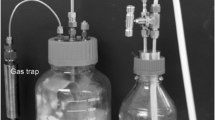Abstract
Malt extract agar and an incubation temperature of 5 °C were used to selectively isolate representatives of the genus Mortierella from soil. Fungi in a soil sample from mountain grassland able to grow under these conditions, amounted to a total of 2640 colony forming units per gram soil. Circa 94% of the total fungal isolates represented Mortierella subgenus Mortierella. The rest of the colony-forming units consisted of Mucor isolates (6.0%) and higher fungi (1.5%). All the Mortierella isolates produced arachidonic acid.
Similar content being viewed by others
References
Amano N, Shinmen Y, Akimoto K, Kawashima H & Amachi T (1992) Chemotoxonomic significance of fatty acid composition in the genus Mortierella (Zygomycetes, Mortierelaceae). Mycotaxon 44: 257–265
Bajpai P & Bajpai PK (1993) Eicosapentaenoic acid (EPA) production from microorganisms: a review. J. Biotechnol. 30: 161–183
Bajpai PK, Bajpai P & Ward OP (1991) Arachidonic acid producing fungi. Appl. Environ. Microbiol. 57: 1255–1258
Benny GL (1995) Observations on Thamnidiaceae. VII. Helicostylum and a new genus Kirkia. Mycol. 87: 253–264
Benny GL & Benjamin RK (1975) Observations on Thamnidiaceae (Mucorales). New taxa, new combinations, and notes on selected species. Aliso. 8: 301–351
Brooks FT & Hansford cg (1923) Mold growth on cold-store meat. Trans. Br. Mycol. Soc. 8: 113–142
Butte N (1983) Rapid method for the determination of fatty acid profiles from fats and oils using trimethyl sulphonium hydroxide for transesterification. J. Chromatogr 261: 142–145
Carreiro MM & Koske RE (1992) Room temperature isolations can bias against selection of low temperature microfungi in temperate forest soils. Mycol. 84: 886–900
Domsch KH, Gams W & Anderson T-H (1980) Compendium of soil fungi. Academic Press, London
Bicker A (1970) Vertical distribution of fungi in Zululand soils. Trans. Br. Mycol. Soc. 55: 45–47
Eroshin VK, Dedyukhina EG, Christyakova TI, Zhelifonova VP, Kurtzman CP & Bothast RJ (1996) Arachidonic acid production by species of Mortierella. World J of Microbiol. and Biotechnol. 12: 91–96
Gams W (1976) Some new of noteworthy species of Mortierella. Persoonia. 9: 111–140.
Gams W (1977) A key to the species of Mortierella. Persoonia. 9: 381–391
Hesseltine CW & Anderson P (1956) The genus Thamnidium and a study of the formation of its zygospores. Am. J. Bot. 9: 696–703
Hesseltine CW & Anderson P (1957) Two genera of molds with low temperature growth requirements. Bull. Torrey Bot. Club 84: 31–45
Kendrick A & Ralledge C (1992) Lipids of selected moulds grown for production of n-3 and n-6 polyunsaturated fatty acids. Lipids 27: 15–20
Kock JLF (1988) Chemotaxonomy and yeasts. South Afr. J. Sci. 8: 735–740
Lomascolo A, Dubreucq E, Perrier V & Galzy P (1994) Study of lipids in Lipomyces and Waltomyces. Can. J. Microbiol. 40: 724–729
Low AB & Rebelo AG (1996) Vegetation of South Africa, Lesotho and Swaziland. Department of Environmental Affairs and Tourism, Pretoria, South Africa
Manocha MS & Campbell CD (1978) The effect of growth temperature on the fatty acid composition of Thamnidium elegans Link. Can. J. Microbiol. 24: 670–674
Ratledge C (1992) Microbial Lipids: Commercial realities or academic curiosities. In: DJ Kyle & C Ratledge (Eds) Industrial Applications of Single Cell Oils (pp 1–15). American Oil Chemists' Society, Champaign, Illinois
Schipper MAA (1978) On certain species of Mucor with a key to all accepted species. Stud. Mycol. 17: 1–52
Spotts RA & Cervanles LA (1986) Populations of Mucor piriformis in soil of Pear Orchards in the Hood River Valley of Oregon. Plant Disease 70: 935–937
Streekstra H (1997) On the safety of Mortierella alpina for the production of food ingredients, such as arachidonic acid. J. Biotechnol. 56: 153–165
Sutton BC (1980) The Coelomycetes. Commonwealth Mycological Institute. Kew, England
Walker P & Woodbine M (1979) The Biosynlhesis of Fatty Acids. In: JE Smith & DR Berry (Eds) The Filamentous Fungi, Vol 2. (pp 137–155). Edward Arnold, London
Warcup JH (1950) The soil-plate method for isolation of fungi from soil. Nature 166: 117–118
Zychae H & Siepmann R (1969) Mucorales, Eine Beschreibung aller Gattungen und arten diese Pilzgruppe. Verlag Von J. Cramer, Lehre
Author information
Authors and Affiliations
Corresponding author
Rights and permissions
About this article
Cite this article
Botha, A., Paul, I., Roux, C. et al. An isolation procedure for arachidonic acid producing Mortierella species. Antonie Van Leeuwenhoek 75, 253–256 (1999). https://doi.org/10.1023/A:1001848709005
Issue Date:
DOI: https://doi.org/10.1023/A:1001848709005




